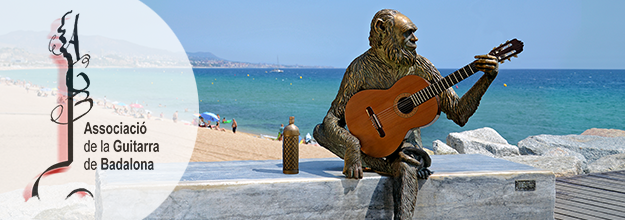Guitarra Badalona weblog
- Hits: 1319
Most people who visit us - especially if they are not from Badalona - wonder about the meaning of the statue of the ape with a guitar that our Association uses as a symbol.
The answer is somewhat complex but very curious. Here we give you the explanation.
- Hits: 1676
 The Argentine musician and composer Ástor Piazzolla was born on March 11, 1921. His work revolutionized traditional tango, incorporating elements of jazz and classical music. He is considered one of the most important musicians of the 20th century. This year we celebrate his centenary with events and concerts around the world.
The Argentine musician and composer Ástor Piazzolla was born on March 11, 1921. His work revolutionized traditional tango, incorporating elements of jazz and classical music. He is considered one of the most important musicians of the 20th century. This year we celebrate his centenary with events and concerts around the world.
In our Autumn Concert 2019 in Badalona, the Argentine guitar quartet “IN CRESCENDO” performed several pieces by Ástor Piazzolla. We share here the video of one of them, "Libertango" to pay tribute to him and commemorate his centenary on his birthday. Thank you for all that you left us. Felicidades Maestro.
VIDEO: LIBERTANGO
More ...
Read More about Piazzolla and watch the "Adiós Nonino" vídeo
- Hits: 937
This is one of the lectures that we enjoyed at the first International Guitar Conference in Badalona, given by Jaume Bosser Artal, who spoke to us about the historical background of the guitar.

In this lecture, Jaume Bosser invited us to take a walk through the history of the precedents of the current classical guitar, especially the vihuela and the different types of guitars, from the Renaissance to the early 19th century.
Bosser showed us the constructive characteristics directly observable in the instruments, but also spoke about their musical and social use in different times and contexts.
If you were unable to attend the lecture, you can now watch it on video clicking the following link:
WATCH THE JAUME BOSSER LECTURE (66' - Spanish)
- Hits: 849
We continue to edit and publish the events of the 2017 International Guitar Conference that we organized in Badalona. It is the turn of the lecture given by the guitar maker and researcher Joan Pellisa on the life and work of Antonio de Torres Jurado, considered the father of the current classical guitars. Pellisa offered us a detailed chronological review of the life of the distinguished maestro.

If you could not attend the lecture, now you can whatch it on video on the page that we have dedicated to, and whose link you will find below. Unfortunately, a technical problem prevented us from recording the final minutes and the conference is not complete, we are sorry, but despite this we have edited and published the 45 minutes recording because we think its content is very interesting. We hope you agree...
Lecture by Joan Pellisa on Antonio de Torres
- Hits: 809
 Applying scientific methods to study the acoustic response of a musical instrument is what Marco Antonio Pérez has been doing with the guitar for a long time.
Applying scientific methods to study the acoustic response of a musical instrument is what Marco Antonio Pérez has been doing with the guitar for a long time.
He is an engineer doctor, but also a guitarist. His research area focuses on experimental characterization and numerical modeling of the dynamic behavior of advanced materials and structures, and he is applying all this knowledge to the study of the guitar.
At the lecture he gave in Badalona during the Guitar Conference 2017, he presented us two of the research projects that he is carrying out.

Thanks to this slightly technical but very entertaining lecture, we were able to see first-hand how he does his work and we became familiar with the tools, methods and techniques that he uses for.
You can find more information and watch the video of this lecture by visiting the page that we have dedicated to. Click at the link:
- Hits: 888
This is a question often asked by those responsible for the conservation and enhancement of ancient instruments, both in museums and in private collections.
The prestigious luthier and guitar-restorer John Ray spoke about this dilemma -focused on guitar - during the Badalona 2017 Guitar Conference, the event organized by our association on the bicentennial of the great luthier Antonio de Torres.
In this interesting lecture, John Ray also explained to us the main difficulties involved in restoring a historic guitar and some of the techniques he uses in his work.
Watch John Ray's entire lecture (42 min.)
Page 2 of 3











